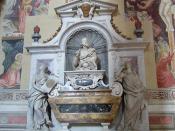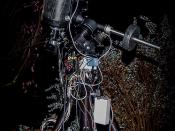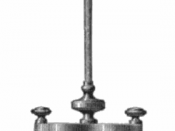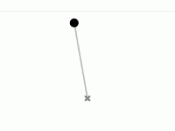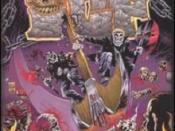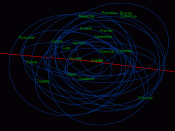Baran 1 Why is the renaissance considered to be one of the greatest periods of human development? Named for the French word meaning "rebirth"� this era occurred from the 14th to the 16th centuries in Europe. It was a time of rebirth of interest in the classical learning of the Greeks and Romans. During this age, artistic, religious, political, and scientific thought advanced significantly. In addition to these achievements, some of the most important scientific discoveries of all time were made including the telescope, the barometer, and the pendulum time experiment.
The telescope is one of the most important inventions of the Renaissance. Hans Lippershey invented the telescope. He was known as the father of the telescope. He was the first person to use a cylinder with a refracting lens. Any telescopes prior to this were made up of just one lens that was not focusable, rendering the telescope useless.
He was the first man to ever gaze into space and discover 2 of Jupiter's moons. He decided to invent the telescope when he saw that the microscope could see very small, so he wanted something that could view another object far away. He was so curious, so he stared at the suns spots too long and went blind (Kozar 33). A second invention of the Renaissance is the barometer. Evangelista Toricelli invented the barometer. He was a famous mathematician and physicist. He was an assistant to the great Galileo Galilee. One day he discovered that he could not pump water more than 40 feet upwards from a well or similar object protruding into the ground. He invented the Baran 2 barometer after this to be able to investigate pressure and why it works like it does (55). He used liquid mercury. Richard Kozar says "The liquid mercury is a vital part of the barometer and is the number one reason why it is so effective and is still in use today by some of the top scientists."� The last Renaissance invention is the Pendulum. The pendulum was the first invention ever to tell time with out the requirement of the sun to be near by. Galileo Galilee was the person who invented such technology. Measuring a specific amount of time was physically impossible until Galileo invented the pendulum (27). He used the length to time ratio to see how long a specific length cord would take for one revolution. No matter how far the pendulum swung, it always completed in an exact amount of time. In the next few paragraphs the inventions will be explained in depth.
The telescope is one of the most fascinating Renaissance inventions created. Its creator, Hans Lippershey, was the man who made it all happen. The original model only had two lenses (FW Telescope). He later added mirrors to the telescope so the he could improve visual quality and zoom ability (FW Telescope). The original telescope was a mere thirty times zoom. Some modern telescopes are several thousand times zoom. He was the first person to view the moons of other planets; he saw several of the moons of Jupiter (Kozar 33).
Some people think that Galileo invented the first telescope, but he did not, because we have written proof of Hans inventing it. Some other people believe Baran 3 that Johannes Kepler invented the first telescope (FW Telescope). Researchers believe that he wrote the plans for it. He couldn't build it because he was very farsighted so he could not see close enough to build the telescope and make it work. Some do believe that he did produce working plans for it but that they were never actually put to work (FW Telescope). His plans were very detailed about the pathway of light but were said to have mathematical errors not allowing the zoom to work properly (FW Telescope). Modern telescopes are nothing more than an added branch to the original telescope. They have added mirrors to easily bend light to be zoomed more and more times without loss of quality. Some mirrors installed have even been carved concave or convex to allow for more bends, which means more zoom (FW Telescope). Our modern telescopes can even see other galaxies, something that neither Hans, nor Galileo would have ever dreamed of doing.
The barometer is the invention of the renaissance that has the most influence on modern society. With it scientists are able to find out certain weather possibilities for the near future. This was set forth in an experiment by Evangelista Toricelli. A glass tube filled with mercury was inverted in a trough of mercury and allowed to seek its own level. Although Toricelli did not construct such an instrument, he understood the physical principles involved (that atmospheric pressure will balance a vertical column of mercury, based upon the altitude at which the column is located) (OL). Because he was able to write and Baran 4 explain such things inventors were able to construct it later on and use it to their advantage. "Robert Boyle (1627-1691), an Englishman, coined the label `barometer,' which first appeared in print in 1665."� (On Line). Soon thereafter scientists began to investigate the relationship between the fluctuations in the height of a mercury tube, and changes in the weather. It was not, however, until the 19th Century that the rise of meteorological science led to radical improvements in the design and use of the barometer (OL). It had no major uses for this time period therefore nothing was discovered with it, because it was not actually made until after Toricelli's death.
The pendulum was very important to the advancement of our society for it provides a way to tell time not requiring any sunlight on a dial. The sundial method is very inaccurate. The pendulum used a weight and a string of equal lengths. Galileo Galilee was the man who invented the pendulum. The pendulum is what he used to measure time in short amounts. When Galileo was in a cathedral, he noticed a chandelier swinging back and forth and he noticed that no matter what the pitch or angle it always makes a revolution in the same amount of time. He called one swing from front to back a period. Each period was equal if the weight remained constant and the same for the length of the rope or string on which it was suspended. In light of this new discovery, He could now measure small lengths of time. Occasionally the pendulum is inaccurate. When the angle of the pendulum is lesser then that of 20 degrees it Baran 5 will go inconsistent until a proper angle is met. Today we know that the period of the pendulum will remain constant as long as the pendulum's angle is no greater than about 20 degrees, and even then, it is not completely precise: "A pendulum moving along a greater arc traverses a greater distance and its velocity is greater, for it falls from a greater height and at a more acute angle. As a result of these factors, its speed is far greater. The surprising conclusion - the pendulum traverses a longer distance in a shorter time, than in a shorter distance, and its period is shorter."� (OL). Today in modern technology, No one has a real use for the pendulum. It is too inaccurate to be effective enough to use for anything serious. It is mainly used in school experiments to explain perpetual motion. Air friction was another problem with this model. Galileo didn't actually know why it was like, this but when Aristotle came around he could easily explain it with his law of inertia.
Inventions are why the Renaissance is considered to be one of the greatest periods of human development. During this, the most important scientific discoveries of that time period were made including the telescope, the barometer, and the pendulum. Without these experiments ever being conducted and explained with "laws"�, we might not ever have had some of the technology we have today that makes certain duties possible in out everyday life.
